by Ian Juby | Apr 23, 2015 | Science Notes
Recently, while Dr. Carl Baugh was on a research trip, questions coming into the Creation Evidence Museum were being forwarded to me. One of them was an excellent letter from a Doctorate in Nuclear Physics. He had asked many pertinent questions which I often hear. So I thought I would post it here for youse guys (that’s Canadian for “y’all”) to enjoy.
Hello Dr. ***********,
Dr. Baugh is out of the country currently, and so your recent letter to him was forwarded to me in hopes that I might be able to respond. My name is Ian Juby, I am a consultant of the museum and a friend of Dr. Baugh’s.
You asked some excellent, pertinent questions which myself and many others have also asked. As fellow skeptics, Dr. Baugh and I respect such questions, and I am happy to respond.
Your first and second question are intimately related, so I will address them both at the same time. You had pointed out that there are no naturally existing long-life isotopes with half lives shorter than 1E9 years. You also enquired about the apparent difference in radiometric “age” between layers that were supposedly laid down by one event, the global flood of Noah.
I would recommend an excellent book, the RATE II book, which is the compilation of an eight year study carried out by a team of scientists. It is
available for purchase online at the Creation Research Society’s website: http://creationresearch.org/Merchant2/merchant.mvc?Screen=PROD&Product_Code=BK-RAD2&Category_Code=B&Product_Count=139
Creation Research Society was one of the organizations that helped fund this study. It is an expensive book at $80, but worth every penny. I will give you the run-down on the results in a moment, but first, let’s look at some background information:
C14 in “old” rock layers:
The Creation Evidence Museum is built on the banks of the Paluxy River, which is famous for its “Cretaceous” dinosaur footprints. These are supposed to be ~100 million years old by conventional dating methods. As I’m sure you are already aware, one cannot date sedimentary rock, therefore these ages are relative to other layers which can be dated. However, these layers contain quite a bit of biomatter, such as coalified plants or dinosaur bone, which can be carbon dated.
Dr. Baugh and numerous others have succesfully obtained C14 dates from such samples for decades now. These dates vary from 5,000 to
50,000 “years BP.” Hugh Miller compiled many of these results, and results from multiple samples from literally all over the world, in his article in Creation Research Society Quarterly (Vol 43, No. 2, pg 84, September 2006 “Pioneering 14C Dating of Wyoming Amber and Its Implications for a Young Earth and Global Catastrophism”) I supplied him with some coal samples from the coal beds of Eastern Canada, conventionally dated as carboniferous; I do not know as of yet whether those samples have been tested or not.
John Dougherty also published similar results for numerous gas, oil and CO2 wells – all of which should have absolutely no C14 left in them. Their high C14 ratios indicates an “age” of only a few thousand years – far short of the claimed age of those layers as hundreds of millions of years (Creation Research Society Quarterly, Volume 44, No 2, Fall 2007, Dougherty, “Deep Wells – Deep Time?”, also “Isotopic Analysis of Fruitland Formation Coal Bed Carbon Dioxide and Methane”, September 2006 CRSQ)
As part of the RATE study, coal samples were collected by Dr. John Baumgardner (Los Alamos, retired) which all had significant levels of C14 in them. Anything older than 100,000 years old should have no C14 in it. As pointed out by Baumgardner and Dr. Russell Humphreys,(personal communication) they took the coal samples (supposedly millions of years old) and sealed them in a barrel purged with nitrogen to counter any possible contamination. While I am certainly not an expert on such matters, I have never heard of anyone taking such steps to avoid contaminating a sample for C14 dating.
But let’s assume that the coal somehow, miraculously, absorbed an equal volume of modern air. This would cause the pMC value to increase by .0001. This cannot account for the pMC values of .2 to .4 that were obtained from this coal. So we have an apparent problem: Many of these layers, or associated layers can be dated using typical rock-dating methods which give “ages” of hundreds of millions, sometimes billions of years – while simultaneously giving Radiocarbon ages of 5,000 to 50,000 years! Which one is correct?
Even C14 dating methods are still founded in untestable assumptions; i.e., the assumption that the C14/C12 ratio in the atmosphere has always been the same. There are many reasons to question the “old ages” (i.e., anything above the half-life of C14, ~5,000 years) of C14 as well.
Other dating methods indicate a few thousand years, not millions
Dr. Robert Gentry published numerous articles on radiohalos throughout the years. One of these articles was a study of these rings of radiation damage (radiohalos) in coalified wood. He noted that the rings were formed, then crushed flat when the wood was compressed into its now coalified state. A second ring was sometimes produced afterwards, and thus was not flattened. Samples were taken from the Eocene, Jurrassic and Triassic – a “time span” of 37 million to 245 million years. However, the radioactive decay of the Uranium within the halos indicated that only “several thousand years” had elapsed since the formation of the coal! There was no “millions of years” – only a few thousand (Gentry, R.V. et al. 1976a, “Radiohalos and Coalified Wood: New Evidence Relating to the Time of Uranium Introduction and Coalification.” Science 194, 315.) All of Gentry’s articles can be found on his website: http://halos.com
Discordant/Discrepant dates produced by dating methods:
Another example of the major contradictions that radiometric dating methods face comes from the Grand Canyon. For simplicity, I’m including this image from one of my slide shows:

Various radiometric dating tests were performed on two lavas in this area; the Cardena basalt (in the supergroup, lower arrow) and the lava flows on the plateau, which flowed into the canyon. Clearly the plateau flows are younger, yet the R-S isochron methods gave it an older age of 1.27 billion years compared to the Cardenas basalt which gave an isochron age of 1.1 billion years at most!
This was compiled primarily in “Grand Canyon: Monument to Catastrophe” by Dr. Steve Austin, which sadly I can’t seem to find anywhere, however, it was also referenced in Dr. John Morris’s book, “The young earth”, which is available through Creation Evidence Museum. (254-897-3200)
To top it all off, follow this link:
http://bara.arizona.edu/research/stoffle/volcano/presentations/Alaska3-PuhaPaths-SouthernPaiutePilgrimagesonAZSt.pdf
Specifically pay attention to slides 19 through 23. The Native Indians actually captured some of the flowing Uinkaret lavas as part of their
religious rituals. Therefore we know that those lavas flowed roughly 800 to 1,000 years ago, and the R-S isochron method (deemed one of the most reliable radiometric dating methods ever produced) is completely unreliable – not even close.
As John Woodmorrappe put it, if those who believe in deep time are free to reject the dates that don’t line up with their preconceptions, than so are we. Incidentally, this brings me to another fantastic book on this very subject, “The Mythology of Modern Dating methods”, which I’m sure you would also enjoy very much.
http://creationresearch.org/Merchant2/merchant.mvc?Screen=PROD&Product_Code=BK-MYT1&Category_Code=
John is a methodical researcher and an excellent writer.
Helium retention in zircons:
Creationists had been criticized for years for pointing these problems out. We were told to “make your own dating methods then,” which we did, and this was part of the RATE project.
Dr. Robert Gentry mentioned an anomaly in his research on zircons found in granites many years ago. (Gentry, R.V., 1982b, Geophysical Research Letters 9, 112, “Differential Helium Retention in Zircons: Implications for Nuclear Waste Containment.”) He noticed that the helium produced by the radioactivity of Uranium in the zircon crystals was retained within the crystal. Helium, because of its small atomic size, is quite free to leave the crystal, yet there was an excess of helium within these supposed “2 billion year old crystals.” 2 Billion years was certainly enough time for the helium to leak out of the crystal!
So the RATE team took this concept and ran with it. They made two predictions of the helium diffusion out of the zircon crystals:
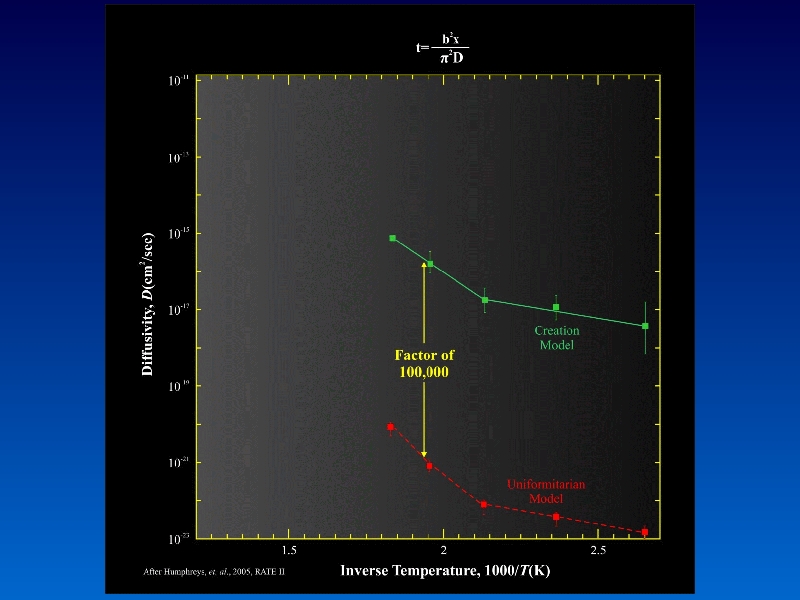
The green bars represent the helium diffusion rate prediction for a 6,000 year old earth, the red bars are the predicted diffusion rates for the 2 billion year old age assigned to the granite the zircon crystals were removed from. The difference between the two is a factor of 100,000 – obviously this removes a lot of experimental error.
When the helium diffusion rates were actually measured, they landed squarely on the predictions for the 6,000 year old earth (results in purple):
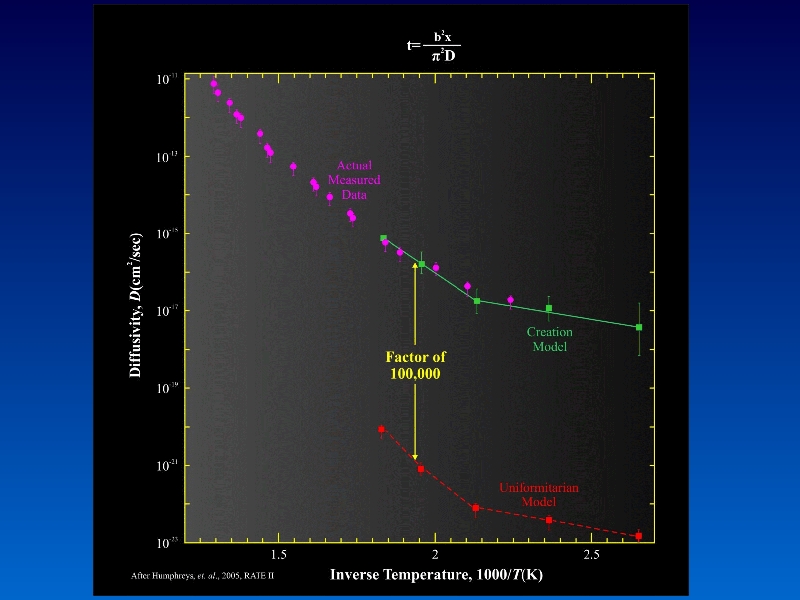
No long half-life isotopes:
This brings me to your first question, which ties in to all of this. Why is there no long half-life isotopes? The amount of helium in the zircon crystals suggests that “2 billion years” of radioactive decay has gone on within the crystal; yet the crystal has only been leaking the helium produced by that radioactivity for a mere 6,000 years. Therefore they concluded that radioactive decay rates in the past were faster than present. To be more specific, the decay rates were inversely affected: the longer the half-life of the isotope, the more its half-life was accelerated. The shorter half-life isotopes had little change to their decay rates.
This throws out all of the old-earth dates that are produced by the various radiometric dating methods, as the assumption that decay rates have always remained the same is untenable. I have only given you a sampling of some of the overwhelming evidence that at sometime in the past, decay rates were radically faster than the present. There’s much more to this which I won’t get into now because I’ve already gone on long enough here.
Ice Cores in Greenland and Antarctica:
Your last question is a common one, regarding the supposed “250,000 years” of layers in the Greenland ice. One must first recognize the assumptions in this “dating method.” It is first assumed that one winter produces one layer. We count the layers, voila – we have an age. If I may respectfully say so, we do not have an “age,” we have a number of layers. The first article I would point to is from my good friend, Michael Oard. He is a meterologist who has taken a strong interest in geology and geomorphology in his later years. He specifically addressed many of the arguments used with the Greenland ice cores in the Technical Journal; conveniently, the entire article happens to be online: http://www.answersingenesis.org/tj/v15/i3/greenland.asp
However, perhaps you are familiar with “The lost Squadron?” This was a group of aircraft that crash-landed on the Greenland ice sheet in 1942, after running out of gas. The aircraft were only lightly damaged, and so years later, an expedition was launched to salvage the planes in 1988. This was featured in National Geographic in 1992. The search team was rather surprised to find that the planes were buried underneath 250 FEET of ice! Clearly the assumptions involved with the annual deposition of ice layers is wrong, as this works out to an average of over 5 feet per year! There is an excellent article, again conveniently on the Answers In Genesis Website: http://www.answersingenesis.org/creation/v19/i3/squadron.asp
This was published in Creation magazine, Volume 19, Issue 3.
Some will still contend that the layers indicate “years”, but I would once again point out that the observations are interpreted to indicated annual
layers. In short, assumptions are simply not fact. On behalf of Dr. Baugh and the folks at the Creation Evidence Museum, thank you for writing, and I’m glad to hear you and your wife enjoy “Creation in the 21st Century.” I hope I have answered your questions. Feel free to email me directly if you have any others, and I’ll see what I can do.
Yours truly,
Ian A. Juby
by Ian Juby | Apr 23, 2015 | Science Notes
I like being a nice guy.
I like to encourage people and speak of the good things that they do. But when someone decides to publically oppose the truth, using falsehoods, while making increasingly condescending remarks, then there’s not much else I can do except publically rebuke them. When you take it upon yourself to oppose the truth with falsehoods, you will lose. And so….
A few days back, I posted some further X-rays from the CT scans of the Delk track on my official “Delk track” page. This was in response to a question by username “ftom2006” over at the Delk track video on youtube. [At the time of this writing there are well over 700 comments on the video – all the quotes here are buried in the comments there]
He had a good point which I felt should be addressed, basically stating that if the density gradients show that the lowest density in the rock revealed that it has the density of a jellyfish (for example), then there’s something wrong.
I wanted to be respectful to ftom, as at the time, he was being quite respectful. But his comments were also raising some concern – he seemed to know something about what he was talking about, but also made huge errors in his claims. His first big blunder was in trying to pass off the high-density area at the junction of the dinosaur toe and the human track as simply an artifact of beam hardening:
“Actually, there’s nothing special about the alleged 4 cm deep ‘high density’ point (07:40). Similar to the ends at the smaller sides of the rock, that’s an area of morphologic edges, and it shows a variation in brightness compared to the alleged ‘low density’ areas exactly as it has to happen due to beam hardening.”
Common sense would say that’s ridiculous, as this would completely invalidate CT technology: What’s the point of buying a bazillion dollar machine if it throws out random errors on the order of centimeters deep?
But to be sure, I asked not one, but two separate CT technicians about this, quoting ftom’s comment. They both said the same thing, almost verbatim: “….that’s…. just …. not possible!” They were both rather surprised at such a ridiculous suggestion.
I addressed this erroneous claim of beam hardening, and a whole wack of other claims on my official Delk track page.
Despite this ridiculous claim, I did feel his questions about density variations and sample measurements were quite reasonable and called for. I had to wait several days for the CT tech who actually carried out the scans on the Delk track, as he was out of his office for several days. Though I already had the full suite of X-rays from the Delk, including the ones with density sample sites, I had several technical questions that I wanted to ask the technician. After having a very enlightening conversation with him, I posted some of the highlights on my official Delk track page, as well as the X-ray scans which had the density sample sites on them.
Ftom then posted back a very long, technical, impressive sounding response that was sure to send the Delk track proponents scurrying! And consequently, he started getting a little lippy.
(note: I’m not going to sit here and nit-pick over spelling mistakes, etc… So don’t expect a [sic] at every single mistake – this is the internet, and I think people are allowed to make speeling mistakes in posts.):
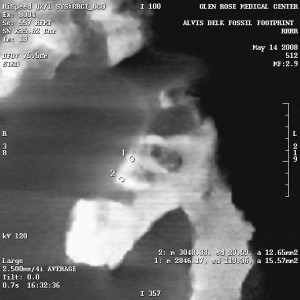 Ftom wrote:
Ftom wrote:
“[1] Well, since absolute density values are still missing: one does not really need to know the absolute density values to evaluate the scan results. If the inherent assumptions of the method, like detection of transmitted intensities, no scattered fraction, no beam hardening would be true, indeed, there would be an essentially linear relation between the Hounsfield number and the true density values.
A minimum HU of 488 (Fig. 7e, #3) and a highest HU of 3048 (Fig. 7a, #2) are given for the rock on the ianjuby-Delk website. Both values are clearly distinct, since the internal precision (sd) of the HU determination reads about 1% for the highest, 5-10% for somewhat lower, and 25% for the lowest values. Whatever the absolute apparent density values, their difference translates to the fact that the minimum apparent density is only about 16% (=487*100/3048) of the maximum apparent density.
Let’s consider the consequences in case that the apparent density variations, as obtained from uncritical HU reading, would be mistaken to reflect true physical densities of the rock. The investigated sample appears to be some impure limestone, someone please correct me if I’m wrong. Accordingly, the rock is essentially composed of the mineral calcite (CaCO3). Calcite has a density of 2.71g/cm^3.
 This value is the maximum physical density for a 100% dense, totally compacted limestone at room conditions, just as Delk proponents are about to sell for the rims of this slab.
This value is the maximum physical density for a 100% dense, totally compacted limestone at room conditions, just as Delk proponents are about to sell for the rims of this slab.
Accordingly, the minimum apparent density corresponds to the value of 0.43g/cm^3. This is simply not a realistic density for this rock, not even remotely, not at all. The corresponding absurd rock would be a limestone composed of 84% porosity and 16% calcite floating in air. Adding some impurities like mica or quartz won’t change anything significant in this estimation.
Prize question, therefore, which of the two is hollow and rattles if shaken: the Delk slab or the oversimplified notion that HU readings correspond to the physical density of this rock?”
Prize question indeed!
It’s at this point that I usually just sit and wait, to see if the skeptics are going to sink their ship just a little bit more, or start frantically bailing the boat and trying to patch the holes.
But wait – Glen Kuban (username “nabuk3” on youtube), apparently revelling in the “thorough debunking” of these sophisticated CT-scans, decided to jump on the ship as it was going down:
“ftom, Thank you for contributing your expertise and insights. To boil it all down… do I understand you correctly to say that in this case the print proponents were _not_ justified in assuming, as they seem to have done, that lighter areas = higher density = compaction?”
Ftom replied in a string of impressive sounding comments, based on his original analysis:
“Yes, nabuk, equation essentially _not_ justified. The estimates demonstrate that the apparent density differences are far too large to represent true density differences.”
“Starting with lower density of a more realistic, porous limestone (e.g. ~2.2 g/cm^3) would just worsen the situation, yield even more absurd, low density values for the core of this rock (~ 0.35 g/cm^3). In this case, the whole slab is likely to float in salt water. Turning the model around, starting with a realistic density assumption for a porous limestone in the core (~ 2.2 g/cm^3) would necessitate a density of ~ 13.8 g/cm^3 for the a rim of this slab, i.e a density higher than elemental iron (~7.9), somewhere between a bar of lead (~11.4) and native gold (~19.3 g/cm^3).
Inherent assumptions for X-ray CT density measurements had not been fulfilled in the case of this rock-shaped, rock-dense object. ”
It’ll float on water….?
Through a bunch of convoluted math and illogical reasoning, ftom used the Hounsfield numbers to “calculate” the density in the center of the rock. A Hounsfield unit of 487 in this case (figure 7e, sample 3). By his reckoning, the rock density at this sample point must be on the order of 0.43 g/cc (0.43 grams per cubic centimeter). And of course to come to that figure, he was being generous to us creationists. As he astutely pointed out, anything of this density will float.
It was Andrew Rodenbeck, a guy who knows nothing about CT scanning technology, who pointed out the first, most obvious error in ftom’s logic and calculations.

CT scanners produce Hounsfield numbers. The Hounsfield scale is based on water and air. Air is -1,000 (negative one thousand) on the scale, water is zero. As an example, bone can be anywhere from a few hundred to a few thousand Hounsfield units, depending on the bone and where the sample is taken. The CT scanners are calibrated to the density of water as their zero point.
Correct me if I’m wrong, but I believe that 487 is a higher number than zero. If a Hounsfield unit of zero is equal to the density of water, and water has a density of 1 g/cc, one does not have to be the head cashier at Walmart to realize that a Hounsfield number of 487 must represent a density much higher than 0.43 g/cc, as ftom claimed.
The third major blunder he pulled off relates to the second. In his words, “the minimum apparent density is only about 16% (=487*100/3048) of the maximum apparent density.”
The density “zero” point is -1000 Hounsfield units, not zero Hounsfield units. Ftom incorrectly attributed the entire density span of the rock to the 3048 positive Hounsfield units, instead of the full 4048 HU. So the minimum density is actually 37%, before any error margins are considered.
In fact, if ftom had stopped for a moment to think (more on this in a second), even without calibration on the CT scanner, there was lots of clues that he was in error.
For starters, one can get a pretty good handle on the density variations within the rock. For instance:
- We can give a very good guess-timate on the density of the rock, and therefore can get a pretty good handle on what density the highest HU value represents.
- We can then approximate densities using the Hounsfield numbers
- The lowest reading was clearly an outlier in the measurements
- Other sample readings of CT scans can be used as a gauge for density gradients within the Delk CT scans
- For the sake of our study, we are only concerned with sub-surface density variations
Sample measurements from other CT scans:
In all the fray, apparently ftom forgot the sample readings of selected Hounsfield numbers that I provided from various places on a random CT scan of a single patient, on the very same machine the Delk track was scanned on. I’ll repeat them here:
- Air inside a lung: -651 (note this is negative)
- Cortical bone: 172
- Liver: 33
- Rib center: 104
- Rib surface: 754
- Vertebrae: 195
It should be noted that these were select readings from a single patient, and not an average. The fact that 487 is considerably higher than most of the bone samples I provided should’ve been a clue to ftom that somethin’ wasn’t quite right in his equations. Bones sink in water, therefore their densities are higher than 1g/cc, and the reading of 487 was higher than the average bone density. Instead, apparently he forgot this in his “expert analysis.”
In fact, he questioned the sample reading I provided from Cortical bone. He was quite right in that this is one of the densest bones in the body… which is precisely the reason that the CT technician who gave me that number chose that location! I thought perhaps I had made a mistake in transcribing the number, but fortunately, I had recorded the conversation as it was the fastest way to take notes. Nope, there was no mistake.
This just goes to show you that a single, low-density reading is not the end of the matter. If we take the maximum error margin for figure 7e, point 3 (HU 614), that’s 40% of the maximum density – a far cry from ftom’s calculations, and is a discrepancy easily explained in a number of ways.
The Outlier:
This lowest Hounsfield number is very much an outlier in comparison to the other numbers. Indeed, it’s deviation (SD) can be +/- 126, or about 25%. In other words, the CT scanner figured the error margin for that number was on the order of 25%!
Clearly, if anything, the number is going to be higher, not lower – simple logic and comparison to the other samples make this obvious. If ftom wishes to disagree and make a fool of himself some more, he’s welcome to.
After all, ftom was very quick to point out the unexpected HU sample reading of the cortical bone that I provided. He immediately spotted it as an “outlier,” and promptly proceeded to replace the number I provided with a number he thought was more reasonable! He then accordingly re-evaluated all the Hounsfield units right across the board!
Now that would be hypocritical of ftom to then criticize me for saying that lowest HU is simply an outlier, wouldn’t it? Especially because – let’s face it – logic is on my side, and not the side of those who would argue that the rock is less dense than the HU’s imply.
As both the skeptics and myself have pointed out, the rock has many thin laminations and cracks. Thus, this one sampling, taken with a circle a mere 7 milimeters in diameter, may very well have landed on a crack or lamination, thus accounting for the lower HU reading.
No, I feel quite justified in claiming that the lowest Hounsfield number is no doubt higher than 614. This number is simply an outlier – the sample site probably landed on an internal crack or something, it is an anomaly.
We only care about sub-surface:
Of course, we are only interested in sub-surface density variations anyway – variations that occur within the first few centimeters of the rock. This is where all of the “action” is going to take place, and as one can see for themselves, we clearly see a lot of variation several centimeters deep into the rock. Thus, once again, the density variations are demonstrated as genuine.
Lastly, as I have already repeatedly said, the images that are displayed are rendered for maximum contrast. This is to make a good visualization of the very real density gradients in the rock. Density gradients which conveniently line up with two fossil footprints – that’s just a little too much coincidence.
Prize question, therefore: which of the two is hollow and rattles if shaken: the Delk slab, or ftom’s analysis of the CT scans of the Delk slab?
Ftom has apparently gone on to other ‘arguments’ about how the “air” looks as dense, or denser in the rock in the CT scan, yada yada yada… But… I don’t look too worried now, do I? You guys are smart – I think you’ll be able to figure out where he went wrong there too.
Why the major blunders?
Sadly, this is typical of anti-creationist writing. This is what I have to deal with all the time. Anti-creationist propaganda is typically very badly researched and written, often containing major logical and scientific blunders – even from experts and very intelligent people. While sometimes I have no doubt it’s deliberate deception, I do think that usually it is just honest mistakes – but why so many, and so often?
The reason is because the anti-creationists usually venture into nit-picking the evidence, trying to discredit it. As my good friend David Lines says, “They are looking at the eyelid of an elephant through a microscope. As a result, they can’t see the elephant that is about to crush them.”
All too often this nit-picking is to serve no other purpose than to obfuscate the evidence – distract people with so much nonsensical information and impressive-sounding arguments that people will simply not look at the evidence.
The elephant in the living room is obvious to anyone who looks at the Delk track: It is profound evidence that dinosaurs and humans lived together. Don’t let anybody distract you away from this very simple, observable fact.
Indeed, it would appear that we are *quite* justified in assuming that “lighter areas = higher density = compaction”
And by the way Glen Kuban – yes, I do still stand by what I said about the Limestone cowboy. But I’ll deal with that subject later on.
by Ian Juby | Apr 23, 2015 | Science Notes
I must admit, that I was surprised by the old “vestigial organs” argument. I really shouldn’t have been, but I was. I thought these evolutionists had grown up past these childish things by now, but I forgot – this is a propaganda piece. I am also absolutely blown away by how imagination is portrayed as science in this segment, and just how utterly ludicrous these imaginations are! Hold on to your hats, this is going to get wierd.
Vestigial organs?
(appendix image from Gray’s anatomy, 20th US edition)
According to the theory of evolution, we “evolved” from lower life forms. A simplified rendition would be that a frog turned into a prince, and that prince happened to be your ancient ancestor, so you happen to have had a frog in your distant past. In case you think I’m exagerating, wait for it.
As a result of this step-by-gradual-step process, leftovers from the frog, or fish, or whatever, remain in your body. These are called vestigial organs.
Some evolutionists may claim that we are still evolving, and thus some of your organs are a step in your evolution into…. whatever it is yer evolvin’ into. And these extra / extraneous organs would be called “nascent” organs as they are first appearing.
For the record, I know of no evolutionist who is claiming any organ we have is nascent, but I thought I’d mention it because you will encounter that term when dealing with theoretical evolution in the fossil record.
 There was once a loooong list of supposed supposed recognized “Vestigial organs.” The list was well over 100 quite a few years back, but funny – the list has slooowly dwindled down to a scant ZERO.
There was once a loooong list of supposed supposed recognized “Vestigial organs.” The list was well over 100 quite a few years back, but funny – the list has slooowly dwindled down to a scant ZERO.
Why? Because what was thought to be “vestigial organs” (for no other reason than evolutionary bias and preconceptions I might add!) turned out to be organs that served a purpose! Stay tuned to this concept, as I will revisit this in the “Evolution in the everyday world” segment.
For example, it was not long ago that the appendix was cut out of people regularly (see image right). All too often it was when there was absolutely nothing wrong with the person’s appendix, but the doctors were going in for surgery in that area anyway, and “it serves no purpose – it’s just a leftover from our evolutionary ascent anyway – let’s cut it out and be done with it.”
In fact, Wikipedia still lists the appendix as a vestigial organ: http://en.wikipedia.org/wiki/Vestigial_organ
Turns out the appendix is the “storehouse” for beneficial bacteria. These bacteria normally reside in your intestine and help you digest your food. Sometimes, due to illness, your body gets rid of the bacteria. The culture in your appendix helps repopulate your intestine.
Creationists would claim that we were designed, therefore, every organ and body part has a function and a purpose. So one must first realize that not knowing what a body part does, only speaks of our ignorance, not our evolutionary past.
The Subtle Arrogance:
Now I’m going to use some strong words here that are not intended to be insulting, but are appropriate.
A major blunder that anti-creationists (and some evolutionists) make is in a very subtle arrogance.
I’ve heard many anti-creationists say things like “If God is so perfect, why did he do such a lousy job in designing the human body? Why is the retina of the eye built upside-down?” yada, yada, yada…. yaaaawn.
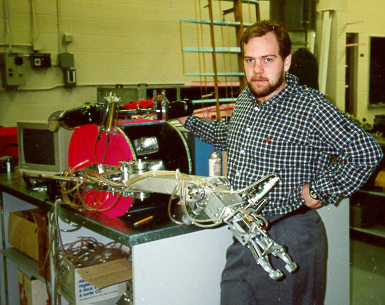 A good dose of humility is required here. As an engineer, I’ve had repeated, healthy humiliations. For example, years ago, I built a series of submarine robots. The reason I built a series is because I was young, foolish, and didn’t know what I was doing. The robots had a nasty habit of failing – and sinking. Yes, I know, submarines are supposed to sink – but not in this way. And believe it or not, sometimes the problem was the submarine wouldn’t sink!
A good dose of humility is required here. As an engineer, I’ve had repeated, healthy humiliations. For example, years ago, I built a series of submarine robots. The reason I built a series is because I was young, foolish, and didn’t know what I was doing. The robots had a nasty habit of failing – and sinking. Yes, I know, submarines are supposed to sink – but not in this way. And believe it or not, sometimes the problem was the submarine wouldn’t sink!
Anyway, I’d wind up going back to the drawing board over and over and over again.
I remember when I first set out to do this, I saw other, commercially available ROV’s (Remotely Operated Vehicles), but the design was too complicated for me to build in my limited shop. I felt I could build it better and simpler (and cheaper, seeing as how I was funding the whole thing myself!).
Let’s just say I learned an awful lot about what works, and what doesn’t work, by experience. In the end, if I were to build a submarine robot now, you’d find my robot would look strikingly similar to the other, commercial designs that I originally rejected.
Why? Because there are specific reasons submarine robots are designed the way they were, in order to make them work!
Sadly, most evolutionary theorists aren’t engineers. Perhaps they should quit their day jobs for a couple of years and take up engineering. They might be converted to creationists by the time they get back to their original job as an evolutionary theorist!
You see, when a person looks at the design of the human body, and claims that it is a “poor design,” they are making an unbelievably ignorant and arrogant statement.
My response is simple: Impress me! Talk is cheap! You think you’re so good, then build me any human organ, from scratch. Then we’ll talk.
I say this because A) Anyone who criticizes the design of any living organism is horribly underqualified to make criticisms. It’s like a kindergarten student telling a NASA engineer that his design of the space shuttle is “poor.” It is arrogant and ignorant. By building a human body from scratch, you will be quite a bit more humbled and a little slower to criticize the Creator.
B) When you have designed and built a human body, from scratch, not only will it make you more qualified to comment on the design, I can also promise you that you will wind up agreeing with the designer’s original design. You will learn (the hard way) why the human body was designed the way it was.
With all of these things in mind, let’s examine what Mr. Shubin brings to the table in terms of supposed “evolutionary leftovers” in his article “This Old Body.”
The Spermatic Cord:
(no, not the band called spermatic chord…)
After complaining about how the spermatic cord (image right from Gray’s anatomy, US 20th edition) in men is routed in a round-about way, Shubin offers up a convoluted evolutionary explanation for why the cord is routed the way it is.
In graphics reminiscent of Haeckel’s long-discredited embryos, Shubin tries to paint a story of the development of the human male gonads in relation to the gonads of a shark. FYI: Haeckel’s chart of embryonic development, though exposed as fraudulent in 1874, is still in high school textbooks today to convey evolution. I kid you not.
I couldn’t help but notice the similarities between Haeckel’s arguments and Shubin’s. For the same reasons Haeckel’s arguments are bogus, so are Shubin’s.
While it’s true that the gonads in a human embryo are “higher up” in the body at 1 month old (see the SciAm drawing), at this point the baby is a whopping 1 centimeter long! (3/8″)
Ummm… where else are you going to put the gonads?
Secondly, let us not forget that the fetus can become either male or female, and so for females, the gonads stay higher up in the body anyway! For males, they simply drop down later on in development. This is efficient design and use of materials.
This has absolutely nothing to do with sharks, except in the fruitful imaginations of those who want desperately to somehow make a relationship between a fish and a human. What a stretch! This is no different than Haeckel’s embryos, it’s just dressed up in a different package. Read Jonathan Wells’ excellent article on this subject, and I will simply repeat his closing comments:
As recently as 1976, biologist William Ballard (who, according to Richard Elinson, coined the term “pharyngula” [Elinson, 1987]), lamented the fact that so much energy continues to be “diverted into the essentially fruitless 19th century activity of bending the facts of nature to support second-rate generalities.” Ballard concluded that it is “only by semantic tricks and subjective selection of evidence” that one can argue that the early stages of the various classes of vertebrates “are more alike than their adults.”
The Spermatic Cord, part II:
So Shubin then ventures into the subtle “poor design” argument, noting that the routing of the spermatic cord can cause inguinal hernias in men.
He doesn’t mention that females also get inguinal hernias almost as often as men do. In fact, women get femoral hernias five times more then men do, for reasons similar to those Mr. Shubin cited for the inguinal hernias, but in a different part of the body. Because women have wider hips, the hernia happens where the femoral vein and inguinal ligament enter the body wall at the lower side of the pubic bone.
So how is the evolutionary theorist supposed to explain femoral hernias with regards to evolutionary development? From what are our femoral arteries left over?
Hiccups prove evolution:
Oh ya folks – here we go! Finally – we have proof of evolution! At least, according to Shubin we do, as this hypothesis is “well supported” (pg 67, first sentence).
Mr. Shubin ventures into the typical argument that he obviously knows how to design a better human body, saying “A more rational design of the human body would have the nerves traveling not from the neck, but from a spot nearer to the diaphragm.”
(emphasis mine)
Besides making this irrational claim that he is utterly unqualified to make, he once again tries to relate us to fish!
“Unluckily, we became heir to this design from fishy ancestors with gills closer to the neck, not a diaphragm well below it.”
(emphasis mine)
Funny how these evolutionists, who deny any intelligent design in the universe, always use the word “design,” eh?
Once again, this utterly, completely bogus argument has no basis except in the imagination of Mr. Shubin and other evolutionists of his ilk. But wait – his imagination gets wilder! He then tries to tie hiccups in with tadpoles who have a very interesting way of breathing, and tells us we shouldn’t be so surprised when we tear cartilage in our knees or get back-aches for daring to walk upright, or getting carpal tunnel from typing, ’cause after all – tadpoles and fish never tried to walk upright or type!
And you thought I was exagerating when I said evolutionists claim a frog turned into a prince!
He then rants on about how if you redesign a fish into a human, you’re going to have problems.
Of course. That’s why God designed us in His image, and not in the image of a fish.
This is laughable! Yet here it is, presented as “science.”
Well did the Apostle Paul prophesy of such people who do indeed take the image of God and change it into an image of corruptible man, and birds, and fourfooted beasts, and creeping things. (Romans 1:22, 23)
Let’s examine this quickly before moving on:
Tadpole hiccups:
This reminds me very much of the evolutionary claims of the Coelacanth (said see-lah-canth), a “lobe-finned fish” which is supposed to be our ancient ancestor, just before it walked up on land. As the fish swims with its big fins, it moves the right/front fin forward in time with the left/rear fin, while propelling itself forward with the left/front and right/rear fins.
The silly peoples producing the NOVA program (my commentary here) claimed this was because the fish wanted to walk like you and I – we swing our right arm in time with our left leg, and vice-versa.
This is an interpretation and imagination, nothing more, nothing less. That is the way the fish swims, because it works for that fish. By swimming that way, it maximizes the thrust from its four large fins while expending the least amount of energy.
A tadpole taking a sudden, deep, underwater “breath” is simply the way it breathes, because of its makeup. You want to interpret that as the reason we hiccup, be my guest – just please, please don’t call it science.
 But Shubin keeps citing various maladies, in hopes of convincing readers that either a) there is no creator, or b) if there is a creator, he’s a horrible designer.
But Shubin keeps citing various maladies, in hopes of convincing readers that either a) there is no creator, or b) if there is a creator, he’s a horrible designer.
Whoever engineered the human body is mind-bogglingly intelligent and skilled. I challenge Mr. Shubin to make me a living human being from scratch. Heck – I’d be impressed if he made a dead human being from scratch!
Maladies and sickness most certainly do not prove there is no God. Being a robotics engineer who has created “life” for my pleasure (Revelation 4:11), I’ve found that my profession and hobby has actually helped me understand my Creator better.
Envision if you will, an assembly line of robots.
(image courtesy of KUKA, Germany)
These robots were intelligently designed of course, and on this assembly line, they have one sole purpose in life: To make other robots just like them.
So if a robot comes off the assembly line, and it’s got a malfunction because a bolt is missing or something, does that mean the assembly line had no creator?
To further complicate matters, let’s build an assembly line of robots, and each of the robots has a free will.
Shubin has been allowed the priviledge of going hog-wild with his imagination, so I’ll simply let the imaginations of the readers take it from here.
by Ian Juby | Apr 20, 2015 | Science Notes
The continuing saga of the January 2009 Scientific American “The Evolution of Evolution” special edition – see bottom of page to links to the other commentaries.
“From Atoms to Traits” is the next article in the magazine, for which there’s really not a whole lot to say. It is the typical “Open by stating evolution is a fact, go into a whole pile of science speak, close by pointing out that evolution is a fact, go home and get a coffee.” The majority of the article is interesting, informative, and true. The majority of the article has nothing to do with evolution. But there’s one twist prevalent throughout the article:
The author of this SciAm segment, David Kingsley, (professor of developmental biology at Stanford) starts this segment off with the brazen (and flat-out false) claim that “Modern scientists are revealing how that diversity arises from changes to DNA and can add up to complex creatures or even cultures.” (emphasis mine)
 Let me simply respond to this opening statement by referring you to an excellent book, but it’s a book not for the faint of heart. It’s very technical, although Dr. Sanford did an excellent job of explaining complicated genetics in fairly simple terms – but even then it’s still a tough read for most.
Let me simply respond to this opening statement by referring you to an excellent book, but it’s a book not for the faint of heart. It’s very technical, although Dr. Sanford did an excellent job of explaining complicated genetics in fairly simple terms – but even then it’s still a tough read for most.
“Genetic Entropy” is a compilation of the results of some of the latest research in genetics. The gist of the book is this: The DNA of all of life is deteriorating.
In other words, scientifically speaking, life is losing complexity, not gaining it, as is required by evolution, and falsely claimed in the SciAm article.
Kingsley is correct in saying that changes in the DNA are adding up, however, they are adding up to larger and larger accumulations of errors. Think about it this way: Take a telephone book, or a dictionary. Either one contains a lot of information. Now randomly remove or add random letters throughout the book.
Does such action add to, or take away from, the information?
The answer is obvious: You lose information. Adding letters does not add information, and obviously taking them away does not add information. Now if you used your intelligence to add letters, then yes, you could add information, but evolution is anathema to intelligence. Evolution operates with no intelligence, but uses a whole lot of blind luck – while simultaneously claiming that blind luck somehow formed the seeing eye!
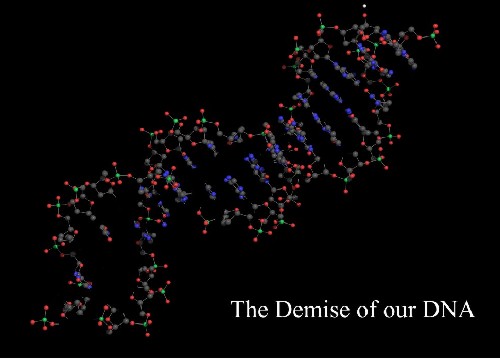 Now back to the genome: We are accumulating random errors in our DNA (the genome), which is the blueprints on how to build you, or a fish, or a tree, etc…
Now back to the genome: We are accumulating random errors in our DNA (the genome), which is the blueprints on how to build you, or a fish, or a tree, etc…
The rates of accumulation for these errors (and loss of information) in the DNA have effectively sealed our “doomsday” for us. In fact, these rates are so high, that it’s alarming.
That doomsday may be hundreds, perhaps even thousands of years down the road, but it does tell us one thing:
We have not been around for millions of years.
For example, read A.S. Krondashov’s 1995 article, “Contamination of the genome by very slightly deleterious mutations: Why have we not died 100 times over?” (Journal of theoretical biology, 175::583-594)
Presumably these observed mutation rates have been going on since the beginning of man. We’re concerned about how much longer we’ve got as a human race, because these mutation (error) rates are so high. So just how have we survived millions of years? I’d suggest we haven’t – we’ve only been around for a few thousand years, and the creation was “perfect” at the beginning, and is deteriorating. But, I’m just a cooky creationist – what do I know.
It also means that we are losing complexity, not gaining it. Our DNA is disingtegrating.
In his article, it appears Dr. Kingsley doesn’t clue in to the significance of what we’re talking about here. On page 55, first paragraph, he says:
“Absolute rates of mutation differ in different species by typically average 10-8 per nucleotide per generation for single base-pair substitutions.”
Doing the math on a 3.2 billion base pair DNA of a human, that’s roughly 32 errors per generation. While this number alone spells doom for humans, the numbers are actually considerably higher. According to Krondoshov, the number is actually between 100 and 300 per generation, and that’s just for the germ (reproductive) cells!
What does that mean? Let me put it to you in terms of a book. We’re going to make a copy of a book that has 3.2 billion letters in it, but replace 32 random letters in the book everytime we make a copy of it. We then take the copy, make a copy of it, adding another 32 random mistakes into it, and so on. How many times can we make these copies before the book becomes unreadable? You see what I’m getting at here: The book will be useable for a while, but continually degrading – eventually getting to the point where it is unreadable.
‘Beneficial’ errors:
There is another error Kingsley makes, and that is the assumption that variation is the result of mutations (errors) in the DNA.
Errors in the DNA (mutations) are not good! For every ‘beneficial mutation’, there are literally millions of neutral to negative mutations – which are preserved and add to a whopper of an error load in the DNA. Yet throughout his entire article, Kingsley props up mutations as the incredible source for the variation of the species!
Now some have claimed that genetic errors have caused a benefit for an organism. While there has been a few cases of arguable benefits from these errors in the DNA, they are exceedingly few, and far between. Also, without exception, every single one of those cases was a loss of information, and a loss of variation with the species.
The variation in the DNA (such as change in hair colour, etc…) are simply programmed into the genes. These variations are not the result of errors, in fact the errors are the source of destruction for the DNA.
A classic example are bacteria that somehow “evolved” to be able to digest nylon. As it turns out, it appears that this is a preprogrammed function in the bacteria (see Don Batten’s article on the AIG website).
The Human Pedigree:
You can’t have good evolutionary propaganda without the nice, fictitious diagrams of ape to man. So SciAm makes sure to not disappoint us. One thing that’s humorous is that I regularly quote a previous SciAm article where the author wrote “The fossils are set in stone, their interpretation is not.” But when it comes to evolution, the fossils are worth far more than their weight in gold, and if you were to weigh the claims made of these fossils, the claims would probably outweigh the fossil itself ten to one!
I’ll address some of the fossils specifically, but first, a quick crash course in identifying fossils.
Ape/human comparisons:
There are numerous differences between ape and human skulls that allows for identification. There are some wildcards though: Let us not forget the incredible variation that can occur within a species (see part 1 of this commentary). Humans and Apes are no exception. Furthermore, the fossil record is one of extinction, and thus we could have a wide variety of apes in the fossil record that are not around today. Furthermore, fossils are typically found crushed, fragmented, or incomplete. There is a lot of room for error, interpretation, and bias. Also, evolutionists (who do most of the digging for said fossils) have preconceived notions about what to find, and can literally mix human and ape fossils together into composite skeletons making true “ape-men”… that never actually existed. Lastly, a little known fact is giantism in the fossil record: Most (if not all) lifeforms had larger representatives in the past then they have today.
These factors alone have a heavy influence on our interpretation of fossils, and the potential for misidentification of fossils.
One difference between apes and humans is the shape of the jaw.

(Original images from “Science vs. Evolution handbook“)
As you can see, apes have a “U” shaped jaw, while humans have a parabolic shaped jaw. Seeing as how evolution has a frog turning into a prince (or an unknown amphibian turning into a university professor if you want to get technical), I’ve included Kermit’s jaw shape for comparison.
Keep this in mind when comparing fossil homind skulls.
Artistic renderings:
But now you’ll notice that in the SciAm article, there are nice drawings depicting what these “hominid” creatures probably looked like. These images serve no purpose, except wild speculation and propaganda. They have no scientific value.
Such images always take “liberties” in their reconstruction. One common tactic used in both magazines and museums is subtle human features depicted on apes. For example:
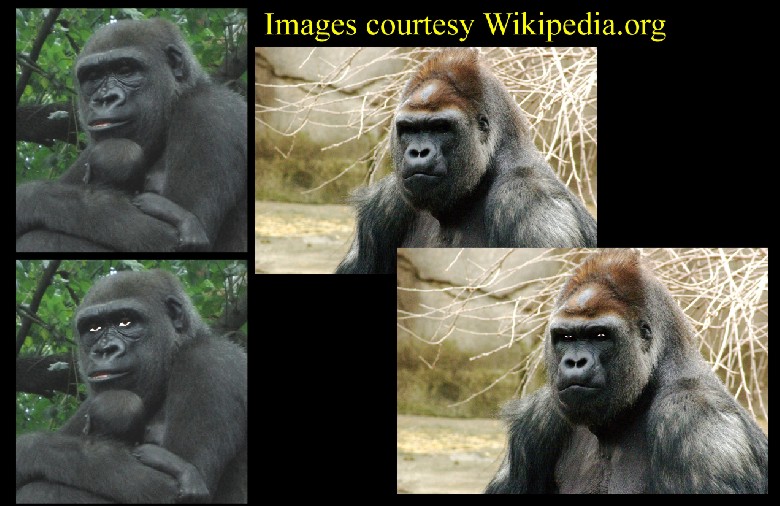
By merely giving human eyes to an ape, or an ape-like creature, human like expressions and emotions (and even intelligence) can be portrayed and communicated. Notice what ape eyes really look like in the untouched photos, and then with human eyes thrown in for effect. It’s very subtle, but very powerful. Now look at the nice brown eyes depicted on homo habilis in the SciAm article.
To their credit, the artists at SciAm actually did make the eyes on the apes look like ape eyes, with the exception of H. habilis.
One major difference between human and ape skulls can actually be seen in some of the pictures of the “hominid” skulls on the timeline chart of pages 61-63. Humans have a bony nose-bridge, apes do not. There is a simple test to tell if a skull is ape or human, I call it the OculusTM test (Oculus is latin for glasses):
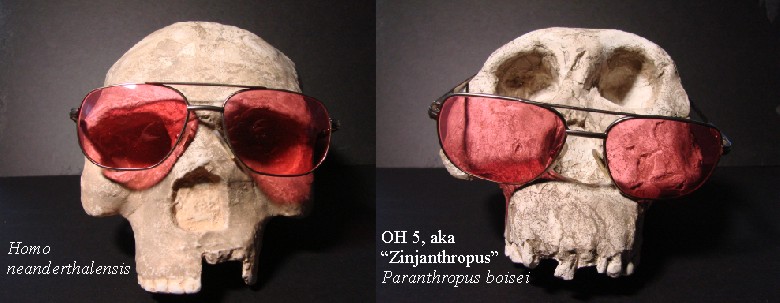
As you can see, Homo erectus is clearly man – he can wear glasses. Zinji on the other hand, cannot because he is missing that vital, bony nose-bridge because he is an ape.
So examining the photos of the skulls in the SciAm timeline (see diagram below on pages 61-63):

You can already get a feel for which skulls are ape, and which ones are human.
Also, you see those nice, pretty lines on the drawing? Those are indicators of the best guess, because of the absence of evidence.
But let’s go down the list of supposed “evidence” that is provided. Rather then reinvent the wheel, I will simply provide links to different online articles dealing with the specific fossils at hand:
- Sahelanthropus tchadensis (aka the Toumai skull): When discovered, was heralded as our oldest relative found to date. Later interepretations labeled it as most likely a female gorrilla (oops.).
http://www.answersingenesis.org/docs2006/0926selam.asp
- In the end, the original discoverers tried to use the hole for the spinal nerve to argue that tchadensis walked upright – but the skull was crushed pretty bad, and this is just more speculation.
- Orrorin tugenensis was found in 2000. Umm… there’s not a whole lot to say here, because there’s not a whole lot of fossil! The interpretations are frankly little more than speculation and wishful thinking. Judge for yourself: http://en.wikipedia.org/wiki/Orrorin_tugenensis
- Ardipithecus ramidus & kadabba, the “Flintstone fossil” (Ardipithecus ramidus kadabba-dabba-dooooo! Thanks to Teno from GEM creation ministries.) Originally the same fossil (Ardipithecus ramidus kadabba), it’s now been split into two separate species. There wasn’t enough fossil to go around for one individual – let alone two species! I will simply point you to two excellent articles, one by science against evolution.org: http://www.scienceagainstevolution.org/v5i12f.htm and one by Dr. Joseph Mastropaolo, who analyzed the “toe bone” that was claimed to be the proof that kadabba walked upright – a toe bone which, I might add, was found kilometers away from the rest of the skeleton: http://www.josephmastropaolo.com/data11.html
- Australopithecus anamensis … notice how only a jaw is shown? That’s ’cause there’s not a whole lot to show! The jaw bone is the best piece, and is clearly ape-like (see chart above). Later fossils of anamensis, found in 2006, apparently showed enough detail to reveal that the locking bones in the wrist were present in anamensis. That means it’s an ape – it has those locking bones for walking on its knuckles. Lastly, the evolutionists themselves debate over the bibedality (upright walking) of anamensis, and some have stated that anamensis isn’t ancestral to humans at all!Further reading farther down the page at: http://www.scienceagainstevolution.org/v12i2t.htm
- Australopithecus afarensis is the group that the famous “Lucy” fossil belongs to. The occulusTM test shows it to be ape, Johanson (Lucy’s discoverer) claims it walked upright, but I deal with this in “The Complete Creation”, part 16, and in “Corrections,” part 19. The afarensis finds, as a whole are clearly ape-like, and may have walked semi-upright, but nothing like a human. They have a strong resemblance to the pygmy chimpanzee.
- Notice that Kenyanthropus platyops is off on its own on the chart? Evolutionists were not exactly thrilled with the discovery of this mashed-up skull, as it upset the current evolutionary thinking… although that seems to happen quite regularly. In fact, Leiberman, writing in Nature, said
“At present, it is hard to believe any reconstruction of hominid relationships because of the abundance of independently evolved similarities in the hominid fossil record. The complex mosaic of features seen in this new fossil will only exacerbate the problem.”
I’ll simply let ScienceAgainstEvolution.org tell the humorous story: http://www.scienceagainstevolution.org/v5i8n.htm
- Australopithecus garhi was originally promoted as a missing link between the Australopithecines and Homo, (actually, it’s not a link that’s missing – the entire chain is gone!) but now it is not even believed by evolutionists to be an ancestor to humans – so why, pray tell, is it on the chart? I would suggest it’s there to help convey the false message that the evidence for the evolution myth is overwhelming, when it is, in fact, dreadfully underwhelming. http://en.wikipedia.org/wiki/Australopithecus_garhi
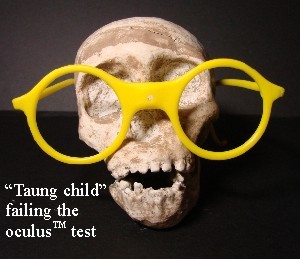 Austalopithecus africanus is listed on wikipedia (that wonderful treasure trove of anti-creationist misinformation) as ancestral to humans… but the chart in SciAm has it as a dead-end branch, just like garhi. Why? In fact, on the wikipedia page, they show the “Taung child” (a skull of which I recently aquired a cast for the Creation Science Museum of Canada), which is nothing more than the skull of a baby chimp.It’s interesting to note that when the discoverers first reported on this skull, its cranial capacity (the space for the brain) was quite large at 510 cubic centimeters.Later reassessments of that capacity dropped it down to 407cc’s! Why the drastic change of over 20%? Because brain capacity plays a role in evolutionary thinking: To an evolutionist, a larger brain equals more intelligence. (See Duffertt’s article in the Sept 1983 CRSQ)
Austalopithecus africanus is listed on wikipedia (that wonderful treasure trove of anti-creationist misinformation) as ancestral to humans… but the chart in SciAm has it as a dead-end branch, just like garhi. Why? In fact, on the wikipedia page, they show the “Taung child” (a skull of which I recently aquired a cast for the Creation Science Museum of Canada), which is nothing more than the skull of a baby chimp.It’s interesting to note that when the discoverers first reported on this skull, its cranial capacity (the space for the brain) was quite large at 510 cubic centimeters.Later reassessments of that capacity dropped it down to 407cc’s! Why the drastic change of over 20%? Because brain capacity plays a role in evolutionary thinking: To an evolutionist, a larger brain equals more intelligence. (See Duffertt’s article in the Sept 1983 CRSQ)
Bottom line: africanus was originally believed to be bipedal, we now know it wasn’t, it’s just an ape. The oculusTM test confirms its ape characteristics as well.
- Paranthropus aethiopithecus: Besides being so ape-like that an amateur can see it (did I mention it fails the oculusTM test?), see that prominent, bony ridge down the back of the skull? That’s characteristic of male gorillas. Also notice again that P. robustus and P. boisei are off on dead-end streets again? Yup, that’s because they’re so ape-like, that even the evolutionists no longer consider them ancestral to humans. They are all apes, nothing more, nothing less.
- Homo/Kenyanthropus rudolfensis (skull KNM-ER 1470) was originally classified as Homo, that is, on the way to becoming human. You’ll notice it’s now been reclassed as Kenyanthropus? You’ll also notice how there’s a dashed line between it and platyops? You also notice that the evolutionary thinkers don’t even have a “best guess” as to where platyops came from? The dashed line indicates that they question the relationship between rudolfensis and platyops! Smthsonian and wikipedia still have it listed in the Homo category. One just has to sit there and scratch his head, wondering what on earth they are doing with this skull. But then, take a look at the history of it, and you’ll being to understand why in “The Rise and Fall of Skull 1470”: http://www.trueorigin.org/skull1470.aspIf you get the chance, you certainly want to read the appendix in Lubenow’s book (mentioned below). This skull provided an excellent opportunity to demonstrate how subjective the “scientific method” of radiometric dating is.
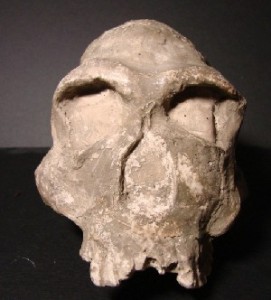 Homo habilis: Skull 1470 was originally classed as habilis, because what was interpreted as stone “tools” were found nearby.Now that 1470 is no longer grouped with habilis, we’ll look at the other habilis fossils, like KNM ER 1813 (on right, also a recently aquired cast for the Creation Science Museum of Canada), OH 7, OH 24 “Twiggy”, and KNM ER 1805. Originally habilis was thought to be the direct ancestor of Homo erectus, until last year. As noted in this BBC article, two fossil discoveries have altered that view, and has led to wild speculation – even on the sex lives of habilis and erectus!Yes, some think you can figure all that out from a fossil.
Homo habilis: Skull 1470 was originally classed as habilis, because what was interpreted as stone “tools” were found nearby.Now that 1470 is no longer grouped with habilis, we’ll look at the other habilis fossils, like KNM ER 1813 (on right, also a recently aquired cast for the Creation Science Museum of Canada), OH 7, OH 24 “Twiggy”, and KNM ER 1805. Originally habilis was thought to be the direct ancestor of Homo erectus, until last year. As noted in this BBC article, two fossil discoveries have altered that view, and has led to wild speculation – even on the sex lives of habilis and erectus!Yes, some think you can figure all that out from a fossil.
Habilis is nothing more than an ape. Check out one of my favourite “ScienceAgainstEvolution.org” pages, on habilis:
http://www.scienceagainstevolution.org/v4i6f.htm as well as Woodmorappe’s excellent article compiling characteristics of multiple “species” of hominds:
http://www.answersingenesis.org/tj/v13/i2/human_fossils.asp
- Homo ergaster is human. It should be noted there are several ergaster fossils, but the size and cranial capacities fall within the variations observed within humans. You can check out a photo here of one ergaster skull, and even with his broken nose bone ridge, he would probably still pass the oculusTM test. Yes, he has very large brow ridges, but that is also present in modern humans! Much is made of prominent brow ridges, but the fact of the matter is, if you look around, you can probably see people in public with brow ridges like that. (Just don’t laugh, and don’t tell them I wanted their picture!) The heavy (“robust”) brow ridges are simply from a tough diet. The muscles from the jaws go up and over the skull, and a tough diet builds both muscle and the bony ridges above the eyes.
- Homo antecessor doesn’t have much left over from his final, very bad day. Take a look here. From what little that can be interpreted from these rather sparse fossils, it does appear to fall within the range of modern human characteristics. You can’t really say a whole heck of a lot about antecessor.
- Homo heidelbergensis is the same build and has the same jaw as modern humans. It has a cranial capacity perfectly within the modern human range. This is evidence of evolution?
http://creationwiki.org/Homo_heidelbergensis
- Homo neanderthalensis (shown above passing the oculusTM test with flying colours) was not human. It was superhuman. Neanderthal man had a larger cranial capacity than we do – so … were they smarter than us? Another excellent article by the folks at Science Against Evolution: http://www.scienceagainstevolution.org/v12i2t.htm but I also need to steer you towards Dr. Pitman Hey’s excellent article on the comparison of human and Neanderthal DNA. The skinny: Modern humans are typically more different from each other, genetically speaking, than the neanderthal is from the average, modern human!
About 2/3 down the page: http://www.detectingdesign.com/earlyman.html
- Homo erectus. Originally thought to have evolved from habilis… until erectus fossils were found in the same layer and not far away from habilis fossils. I don’t think I need to say much. There is nothing un-human about these fossils! So again I ask, “How does this help evolution?”
- Homo floresiensis is the most recent find, and certainly is stirring up debate. You may have heard of this “hobbit” fossil, as it was nicknamed because it was only about 1 meter tall. Found in a cave on the island of Flores, Indonesia, in 2004, these small skeletons are typically 1 meter tall. Some evolutionists have suggested these are simply the remains of humans with genetic disorders like microcephaly, or perhaps poor nutrition. The discoverers are claiming they were a separate species from modern humans.
At this point, there’s not a heck of a lot to say. From what very little I’ve been able to see, I haven’t been impressed with the arguments that they’re not human. As it is, even the evolutionists are up in arms about the interpretation of these bones (which aren’t fossilized). The apparently tools found in the cave appear to be appropriate for a 1 meter tall human, which seems to lend credence that the “hobbit” was an intelligent being. Frankly, even if it turns out to be another “species,” I fail to see how this supports evolution.
Whadabout the ape fossils?
After all of this, have you noticed that evolutionists never seem to find any fossils from apes? It’s intriguing to note that all of these “ape-like” human ancestors are being found, but no ancestors of apes! Coincidence?
 Further reading:
Further reading:
I’d highly recommend Marvin Lubenow’s book on the subject of supposed “ancestral human fossils.” It is easy reading, and chock full of good history and analysis of many fossil hominids.
by Ian Juby | Apr 20, 2015 | Science Notes
Is it evolving, or is it intelligently designed?
I couldn’t resist – I bought a copy of the January edition of “Scientific” American. Obviously this is the first of many “science” magazines that will come out in celebration of Darwin’s upcoming 200th birthday, and the 150th anniversary of his book, “Origin of the species.” (the words “science” and “scientific” in the previous sentences are used loosely)
 Even the title of this special edition is revealing – “The Evolution of Evolution.” The theory of Evolution was Intelligently designed (or arguably with perhaps not-so-much intelligence), and so were its many changes and alterations that it has undergone since its inception.
Even the title of this special edition is revealing – “The Evolution of Evolution.” The theory of Evolution was Intelligently designed (or arguably with perhaps not-so-much intelligence), and so were its many changes and alterations that it has undergone since its inception.
Aside from the oxymoronic title, the cover is chock full of promises for the public to see how evolution is science, and anyone who questions it is considered to be the moron.
But let’s have some fun and peek through the mag, shall we?
Propaganda 101:
Most of the articles are typical evolutionary propaganda: Open with “Evolution is true.” Throw in a whole wack of science speak which has absolutely nothing to do with evolution, then close with “Oh, by the way, evolution is true.” This, of course, is a prerequisite for getting a paper published in a mainstream scientific journal, for without the opening and closing bows at the altar of evolution, well your paper just isn’t scientific!
The propaganda approach is glaring – from trying to equate evolution with the real science depicted in the popular CSI shows (pg 82), describing it as a “theory for every man” that needs to be taught so we can understand true science (pg 32), describing Darwin as a “genius” (pg 40), the wonderful, fact-free but very impressive looking “evolution of humans” chart (pg 61-63), the new-agish and fictitious claim that we are continuing to evolve (contrary to all observable science which shows we are deteriorating) and -incredibly- vestigial organs (pg 64!!!) which were discredited decades ago.
So why on earth would they write on these things which are at best questionable, and at worst completely discredited – and often times discredited even by evolutionists?
It’s because the propagandists are not interested in the facts, they are interested in getting the populace at large to believe their message – even if it requires lying and misinformation. Don’t believe me? Here’s what one evolutionist recently had to say on the matter:
“You cannot bludgeon kids with truth [sic] (or insult their religion, i.e., their parents and friends) and hope they will smile and believe you. Yes, NOMA [a philisophical hypothesis claiming that religion and science can’t mix – it was proven wrong – I.J.] is wrong, but is a good first tool for gaining trust. You have to bring them over to your side, gain their trust, and then hold their hands and help them step by step. And on that slow journey, which will be painful for many of them, it is OK to use some inaccuracies temporarily if they help you reach the students.”
“…it is OK if they keep some of those little inaccuracies for the rest of their lives. It is perfectly fine if they keep thinking that Mickey Mouse evolved as long as they think evolution is fine and dandy overall. Without Mickey, they may have become Creationist activists instead. Without belief in NOMA they would have never accepted anything, and well, so be it. Better NOMA-believers than Creationists, don’t you think?”
“Education is a subversive activity that is implicitly in place in order to counter the prevailing culture. And the prevailing culture in the case of Campbell’s school, and many other schools in the country, is a deeply conservative religious culture.” [emphasis mine -I.J.]
Parents, I hope you’re taking notes here! Did you catch that? This is what they intend to do with your children in school. Yes, you read right – teach your children things that the teachers know are falsehoods, as long as it brings them to a belief in evolution.
This is their ulterior motive, summed up in a nutshell (emphasis on “nut”). Go ahead – read the blog for yourself. Also please note that “Coturnix” (the author of the blog) is also the online community manager for the PLoS ONE on-line science journal. Nope – no bigotry or bias against the truth or creationists here!
But I digress – let’s get back to SciAm and …
Dissecting the propaganda: “Darwin’s living legacy”
It’s interesting that the first article in this special edition has such heavy social implications. Darwin was a man with severe mental problems. He was hardly a genius, though SciAm would like to portray him as such. It saddens me to read of Darwin’s illnesses, and I feel for the man. I am quite confident in what I say here, for I too, for a time, suffered from serious depression and mental instability. Why? For the same reasons I suspect Darwin had his problems: We had both rejected our Creator.
Contrary to what my enemies would have you believe, I am of quite sound mind now – why? Because I turned back to my Creator, Jesus Christ, and He restored our relationship. I can truly say “God hath not given us the spirit of fear; but of power, and of love, and of a sound mind.” (2 Timothy 1:7, KJV, Holy Bible)
Darwin’s psychoses:
http://www.icr.org/article/112/
http://en.wikipedia.org/wiki/Charles_Darwin’s_illness
There are social consequences resulting from rejecting the Creator. The list goes on and on, influencing and affecting others in the “here and now” as well as eternity, but I’ll come back to this later.
Darwin was apparently the first to suggest the thinking that his was the first brain to realize evolution had produced his brain. However, natural selection, and his ideas on evolution that really made him famous, were borrowed (read: “plagiarized”) from his grandfather and many others.
It is particularly noteworthy that the idea of natural selection was a Creationist idea. Yes, you read correctly: the supposed mechanism for evolution that made Darwin the famous “genius” that SciAm claims him to be, was a creationist proposition.
SciAm deems the subject of natural selection important enough to mention repeatedly in their special edition, and I will delve into natural selection next when I address their claims about it.
For the moment though, here’s some good reading on the subject:
“Natural Selection – A Creationist’s Idea”, by Paul Humber, M.S.
http://www.icr.org/article/412/
“Darwin’s illegitimate brainchild – If you thought Darwin’s Origin was original, think again!”, by Russell Grigg
http://www.answersingenesis.org/creation/v26/i2/brainchild.asp
Sadly, Darwin’s reality cheque bounced, along with the reality cheques of most other atheists/anti-creationists who have not stopped to think of the consequences of suggesting that their brain was the result of evolution. C.S. Lewis was a once-hard-core atheist who set out to show Christianity to be the farce that he thought it was, but wound up becoming a born-again Christian, describing himself as “the most miserable convert” ever. He encountered this problem of the evolution of the brain:
 “If the solar system was brought about by an accidental collision, then the appearance of organic life on this planet was also an accident, and the whole evolution of Man was an accident too. If so, then all our present thoughts are mere accidents – the accidental by-product of the movement of atoms. And this holds for the thoughts of the materialists and astronomers as well as for anyone else’s. But if their thoughts – i.e., of Materialism and Astronomy – are merely accidental by-products, why should we believe them to be true? I see no reason for believing that one accident should be able to give me a correct account of all the other accidents. It’s like expecting that the accidental shape taken by the splash when you upset a milk-jug should give you a correct account of how the jug was made and why it was upset.”
“If the solar system was brought about by an accidental collision, then the appearance of organic life on this planet was also an accident, and the whole evolution of Man was an accident too. If so, then all our present thoughts are mere accidents – the accidental by-product of the movement of atoms. And this holds for the thoughts of the materialists and astronomers as well as for anyone else’s. But if their thoughts – i.e., of Materialism and Astronomy – are merely accidental by-products, why should we believe them to be true? I see no reason for believing that one accident should be able to give me a correct account of all the other accidents. It’s like expecting that the accidental shape taken by the splash when you upset a milk-jug should give you a correct account of how the jug was made and why it was upset.”
-C.S. Lewis
Darwin’s book a best seller?
SciAm makes a point to mention a number of things in the timeline on page 40, some of which have absolutely nothing to do with evolution (i.e., Watson and Crick discovering DNA, and Mendel – whose research actually refuted Darwin’s evolution).
 They reiterate the propaganda that’s been running around for years: Darwin’s book sold out on the first day it was released.
They reiterate the propaganda that’s been running around for years: Darwin’s book sold out on the first day it was released.
Isn’t it unusual that SciAm fails to tell the whole story? It’s not like Darwin’s book flew off the shelves in droves – oh no. It was “bought out” by bookstores to stock their shelves.
By comparison, “In the Arctic Seas: A Narrative of the Discovery of the Fate of Sir John Franklin” by Captain McClintock was released on the same day and sold 7,600 copies (to bookstores) the same day. Samuel Smile’s “Self-help” was released and sold 3,200 copies to bookstores, on the same day…. and 20,000 copies by the end of the first year! “Self-help” had sold over a quarter of a million copies by the time Smiles died. However, 13 years and six editions of “Origin of the species” later, Darwin had only sold 12,750 copies of his book. “Origin” averaged sales of about 1,000 copies per year.
SciAm, in the sidebar, describes Darwin as an “approachable genius” with writings that were “remarkably accesible to any literate person.”
Actually, even Leonard Huxley (the son of “Darwin’s bulldog,” Thomas Huxley) wrote “I have read … the Origin for the sixth or seventh time, becoming confirmed in my opinion that it is one of the most difficult books to exhaust that ever was written.” (Life and letters of Thomas Henry Huxley)
SciAm also refers to Darwin’s famous finches, another discredited “evidence” for evolution which will be discussed in the next segment.
I say all of this, not to bad-mouth Darwin, as I frankly feel for the man when I read his writings. Nevertheless, he has been elevated to the status of a demi-god by those who reject their Creator. The SciAm article is only one glorious example of the status that has been erroneously granted to Darwin. Believe me – you do not want to follow in Darwin’s shoes. This is not a man you wish to emulate. Reading his private writings will settle that issue, and right quick – at least, if you’re of a sound mind.
Testing Natural Selection
The next article is devoted to natural selection, which I’ve already shown to be a Creationary idea anyway. Though SciAm spent eight pages on the subject, I will spend a mere couple of paragraphs on the subject.
Surprisingly, evolutionists and creationists agree on almost everything with regards to natural selection! Natural selection, or “survival of the fittest” is an observed phenomena that has nothing to do with evolution. If an animal is sick, or has a genetic issue, its chances of survival (and consequently, chances of producing offspring) are less than those who are healthy. And thus, sick or “less fit” creatures are removed from the population.
We Creationists have no problem with natural selection.
- Natural selection only selects from what already exists. Evolution requires new information, new organs, and new appendages to appear.
- Natural selection does not produce anything new.
- Natural selection removes information – the exact opposite of evolution. For example, breeding dogs into chihuahuas removes variation within the species. So natural selection doesn’t build up a super-dog, but rather over time it converts a super-dog into an animal that wouldn’t survive a day in the wilderness (but would make a nice appetizer for a hungry bear)
- Little changes do not add up to big changes (see below and “From Atoms to traits”)
- Natural selection is not evolution.
Think about it: Place a chihuahua, a great dane, a french poodle, a wolf, and a weiner dog beside each other (if you actually do this experiment, it’s probably a good idea to tie them a safe distance apart from each other). Now observe: This is the kind of variation you can get within a species. They are all dogs. While these are examples of unnatural selection (people bred these different variations deliberately), SciAm seems incredibly impressed with three examples of “Evolution in action” on page 48:
“Wild Rabbit (Australia); Animals brought from Europe changed in body size,
weight and ear size as they adapted to the hot, dry Australian climate.”
Ummm… are they still wabbits? Elmer Fudd would think so. Hey – I changed in size this past year! (That’s what living in your van and eating lots of fast food does) Am I any less human? Am I evolving?
“Scarlet honeycreeper (Hawaii); As its favorite source of nectar began disappearing, the bird sought nectar elsewhere, and its bill became shorter.”
Is it still a Scarlet honeycreeper? Yes.
“Marine snail (New England); Likely in response to being hunted by crabs, the snail’s shell changed shape and became thicker.”
For some evolutionists, that is enough to proclaim it a new “species” (which by the way, there is no real definition for “species.”), but it sure looks like it’s still a snail to me.
Let’s go over this: These incredibly minor variations don’t compare to the variations we see in dogs around the house.

If you want serious variation, driven by serious mutations, just visit Chernobyl. Why – you can see all kinds of creatures growing extra limbs and all kinds of cool stuff! It’s an evolutionist’s dream study! Think of all of the mutations – and the natural selection (read: “background radiation”) killing off the weak – hey!
But evolutionists are not studying evolution there, why not? Aside from the fact that they may start growing limbs and other “cool stuff”, becoming part of their own evolutionary study, there is a deeper reason I think: It’s because then they (and you) would see that “evolution” kills. In the absolute hotspot of “evolution” on the planet, it is amazing that anything survives – and the things that did survive didn’t improve. This is the real evolution, and not that cheap big-box store imitation that SciAm and others try to sell you.
Evolution is not a progression, it is a regression, a loss of information, a loss of variation, a loss of life. That is scientific, observable, testable, and repeatable.
But what of Darwin’s finches?
(image courtesy Big Valley Creation Science Museum, a museum which displays real science)
Okay, so Darwin documented some finches in the Galapagos islands – so what?
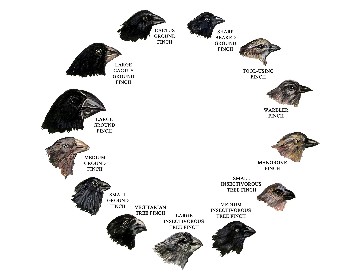 In fact, most people are surprised to find out that Darwin didn’t observe natural selection in the Galapagos finches – in fact, he erroneously labeled some of them as the wrong bird.
In fact, most people are surprised to find out that Darwin didn’t observe natural selection in the Galapagos finches – in fact, he erroneously labeled some of them as the wrong bird.
However, since that time, there has been considerable study of finches on isolated islands, and it’s been educational, but no help to evolution.
After 30 years of studying the finches, and watching rapid natural selection, we still have….. finches.
And apparently these different types of finches can interbreed, which of course means they aren’t different species – merely variations of the same bird.
Further reading:
http://www.answersingenesis.org/articles/am/v4/n1/natural-selection#fnMark_1_19_1
Variations in people:
Variations even occur in humans, due to diet and environment. Here in the Western hemisphere, we have a problem with “wisdom teeth.” In fact, depending on where you are, you may get the evolutionary take on this: Some have claimed that these teeth are “evolutionary leftovers” (vestigials) from our ascent from the apes. Later on, in “This old body” we’ll get a good laugh over some of the ridiculous suggestions of vestigials made in SciAm.
But for now – what about those teeth called “wisdom,” presumably because they smart? In cultures where they eat a hard-to-chew diet (i.e, lots of nuts), the human jaw actually grows the way it’s supposed to and their wisdom teeth don’t collide with their other teeth!
Yup, the jaw becomes “robust” (an evolutionary term) by a simple change in diet, whereas here, we have a dreadfully overcooked, soft diet. As a result, our jaws are underdeveloped. We get a lot of impacting wisdom teeth here, and it has absolutely nothing to do with evolution, or our “ancestral history” from the apes – which, by the way, typically have the same number of teeth we do.
Variation is not evolution.
If you enjoyed this commentary, or if you’re just interested in the creation/evolution debate, may we suggest you:
Sign up for the free “In 7 Days” crash course in creation, delivered course-by-course to your inbox for 7 days
AND/OR
Sign up for Ian’s newsletter and get subscriber priviledges like competing for give-aways and getting the latest info on the creation/evolution debate.
Other segments in this commentary:
“This old body”















 Austalopithecus africanus is listed on
Austalopithecus africanus is listed on  Homo habilis: Skull 1470 was originally classed as habilis, because what was interpreted as stone “tools” were found nearby.
Homo habilis: Skull 1470 was originally classed as habilis, because what was interpreted as stone “tools” were found nearby. Further reading:
Further reading: Even the title of this special edition is revealing – “The Evolution of Evolution.” The theory of Evolution was Intelligently designed (or arguably with perhaps not-so-much intelligence), and so were its many changes and alterations that it has undergone since its inception.
Even the title of this special edition is revealing – “The Evolution of Evolution.” The theory of Evolution was Intelligently designed (or arguably with perhaps not-so-much intelligence), and so were its many changes and alterations that it has undergone since its inception.






